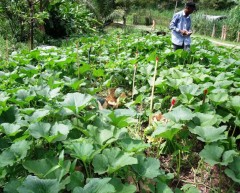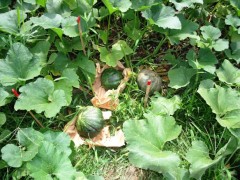Jun 28, 2009
Sustainable Farming
Sustainable farming in practice here:
1. This is a 'No-Dig' 35 feet x 10 feet pumpkin patch. Barely 2 months, we now have 42 pumpkins (the red tips mark the pumpkins), with more to come judging by the flowers.
2. The original soil is sandy. We build up the beds using compost, some soil and mulch.
3. Three varieties of pumpkins are planted here, creating diversity to reduce outbreaks of insect or fungal and bacterial problems. So far we have had one bacterial problem which we quickly addressed by uprooting and destroying the plant. Fungal problems have been minimal and have been addressed by quick action using cassia alata juice. Insects have not been serious. The beetle A. abdominalis is present but does not seem to cause any problems to the pumpkin plants.
4. No purchased fertiliser, or any other input have been used here. We only use our farm made compost.
5. We are now looking forward to see whether a second crop of pumpkins using the same plot of land can produce similar yields. That would really be a test of sustainability.

17:45 Posted in Sustainable Farming | Permalink | Comments (2) | Tags: sustainable farming, pumpkins










Comments
what do u mean by do-dig?
mine to explain?
Posted by: safuan | Jun 29, 2009
No-Dig means the soil is not ploughed / tilled. Advantages include less long term labour, less energy used, less loss of top-soil and microbial diversity. The originator of the idea of not digging is Fukuoka Masanobu. Read his book, One Straw Revolution. In humid countries like Malaysia, one have to be watchful of fungal problems when embarking on heavy mulching, which is often one of the important components of No-Dig agriculture.
Personally, I have this antipathy towards digging the soil. I lose my connection with the soil when it is dug and exposed.
Posted by: HS | Jun 29, 2009
The comments are closed.